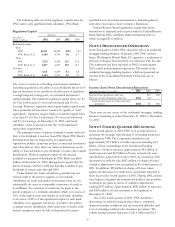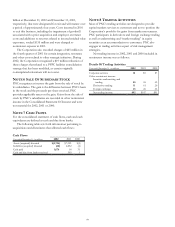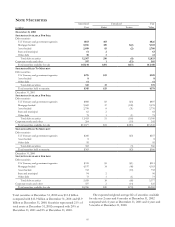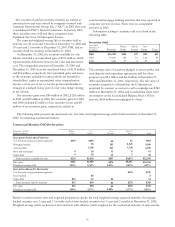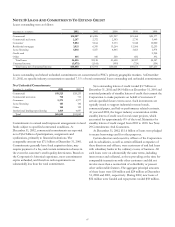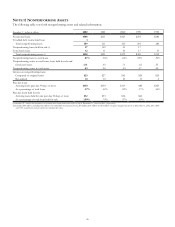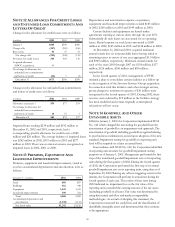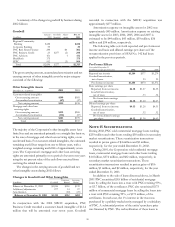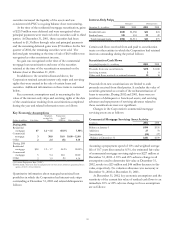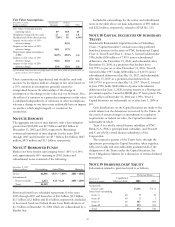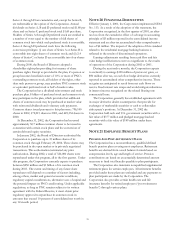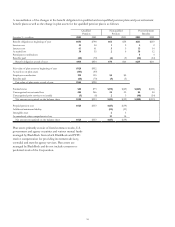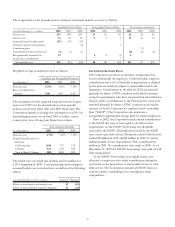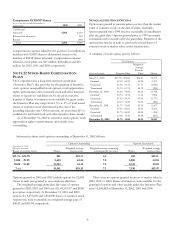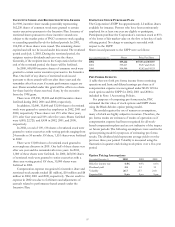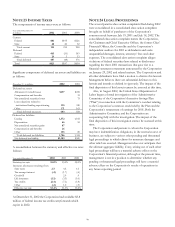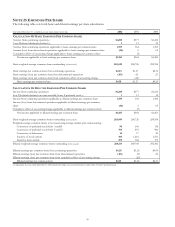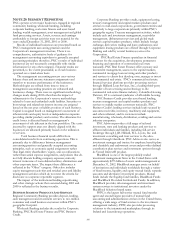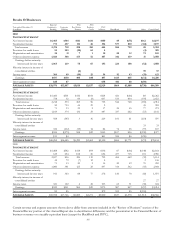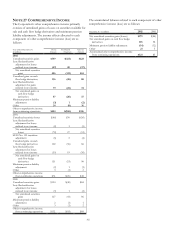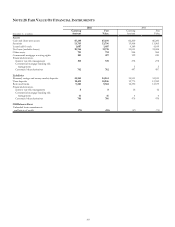PNC Bank 2002 Annual Report Download - page 95
Download and view the complete annual report
Please find page 95 of the 2002 PNC Bank annual report below. You can navigate through the pages in the report by either clicking on the pages listed below, or by using the keyword search tool below to find specific information within the annual report.93
Series A through D are cumulative and, except for Series B,
are redeemable at the option of the Corporation. Annual
dividends on Series A, B and D preferred stock total $1.80 per
share and on Series C preferred stock total $1.60 per share.
Holders of Series A through D preferred stock are entitled to
a number of votes equal to the number of full shares of
common stock into which such preferred stock is convertible.
Series A through D preferred stock have the following
conversion privileges: (i) one share of Series A or Series B is
convertible into eight shares of common stock; and (ii) 2.4
shares of Series C or Series D are convertible into four shares
of common stock.
During 2000, the Board of Directors adopted a
shareholder rights plan providing for issuance of share
purchase rights. Except as provided in the plan, if a person or
group becomes beneficial owner of 10% or more of PNC’s
outstanding common stock, all holders of the rights, other
than such person or group, may purchase PNC common stock
or equivalent preferred stock at half of market value.
The Corporation has a dividend reinvestment and stock
purchase plan. Holders of preferred stock and common stock
may participate in the plan, which provides that additional
shares of common stock may be purchased at market value
with reinvested dividends and voluntary cash payments.
Common shares issued pursuant to this plan were: 796,140
shares in 2002, 472,015 shares in 2001, and 649,334 shares in
2000.
At December 31, 2002, the Corporation had reserved
approximately 30.7 million common shares to be issued in
connection with certain stock plans and the conversion of
certain debt and equity securities.
In January 2002, the Board of Directors authorized the
Corporation to purchase up to 35 million shares of its
common stock through February 29, 2004. These shares may
be purchased in the open market or in privately negotiated
transactions. This authorization terminated any prior
authorization. During 2002, a total of 320,000 shares were
repurchased under this program, all in the first quarter. Under
this program, the Corporation currently expects to purchase
between $250 million and $1 billion of its common stock
during 2003. The extent and timing of any future share
repurchases will depend on a number of factors including,
among others, market and general economic conditions,
regulatory capital considerations, alternative uses of capital and
the potential impact on PNC’s credit rating. Under applicable
regulations, as long as PNC remains subject to its written
agreement with the Federal Reserve, it must obtain prior
regulatory approval to repurchase its common stock in
amounts that exceed 10 percent of consolidated net worth in
any 12-month period.
NOTE 20 FINANCIAL DERIVATIVES
Effective January 1, 2001, the Corporation implemented SFAS
No. 133. As a result of the adoption of this statement, the
Corporation recognized, in the first quarter of 2001, an after-
tax loss from the cumulative effect of a change in accounting
principle of $5 million reported in the consolidated income
statement and an after-tax accumulated other comprehensive
loss of $4 million. The impact of the adoption of this standard
related to the residential mortgage banking business is
reflected in the results of discontinued operations.
Earnings adjustments resulting from cash flow and fair
value hedge ineffectiveness were not significant to the results
of operations of the Corporation during 2002 or 2001.
During the next twelve months, the Corporation expects
to reclassify to earnings $138 million of pretax net gains, or
$90 million after tax, on cash flow hedge derivatives currently
reported in accumulated other comprehensive income. These
net gains are anticipated to result from net cash flows on
receive fixed interest rate swaps and would mitigate reductions
in interest income recognized on the related floating rate
commercial loans.
The Corporation generally has established agreements with
its major derivative dealer counterparties that provide for
exchanges of marketable securities or cash to collateralize
either party’s positions. At December 31, 2002 the
Corporation held cash and U.S. government securities with a
fair value of $377 million and pledged mortgage-backed
securities with a fair value of $149 million under these
agreements.
NOTE 21 EMPLOYEE BENEFIT PLANS
PENSION AND POST-RETIREMENT PLANS
The Corporation has a noncontributory, qualified defined
benefit pension plan covering most employees. Retirement
benefits are derived from a cash balance formula based on
compensation levels, age and length of service. Pension
contributions are based on an actuarially determined amount
necessary to fund total benefits payable to plan participants.
The Corporation also maintains nonqualified supplemental
retirement plans for certain employees. All retirement benefits
provided under these plans are unfunded and any payments to
plan participants are made by the Corporation. The
Corporation also provides certain health care and life
insurance benefits for retired employees (“post-retirement
benefits”) through various plans.


